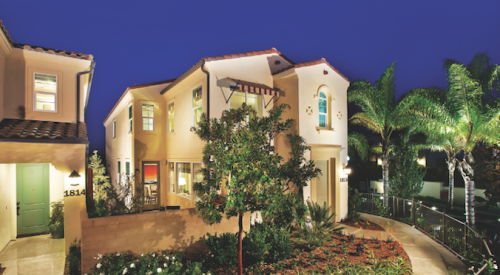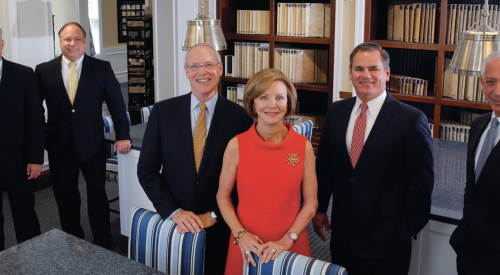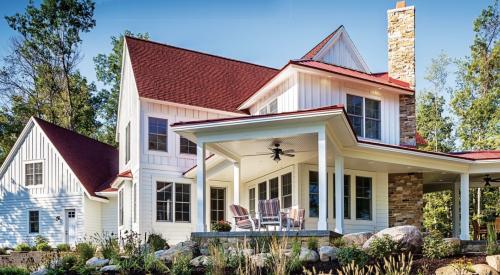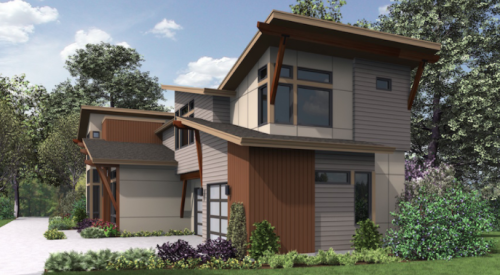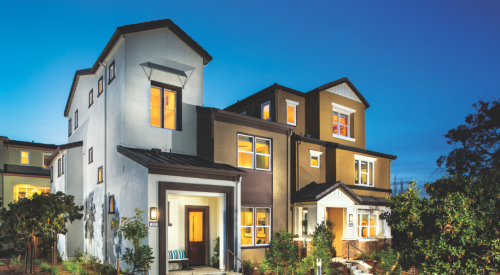|
 |
|
Within reach of much of the home-buying workforce, the Cottage Series at Forest Creek in Parris, Fla., has architectural details generally not found in lower-cost housing. The Rose Cottage is the smallest yet sells best. |
Also working against him, besides the housing downturn: the land he had in his Forest Creek development in Parrish, Fla., was zoned for townhomes, while his buyers wanted the American dream of a single-family home with a yard.
Research and consultation with longtime colleagues Jerry Messman with BSB Design, John Bews at Davis Bews Design Group and the Neal Communities team brought him to what would become the Cottage Series, three styles of single-family homes no more than 1,600 square feet with 2 or 3 bedrooms and 2 to 2½ bathrooms, all on lots 27 feet wide.
The entire process — from conceptualization to zoning approval to finished models — took about six months to boot (see the timeline at the bottom for a breakdown of how it happened).
Prices started then in the $120,000s and now begin at $144,900, which includes front porches with columns, rear-loaded garages, private courtyards and floor plans that respect residents' privacy. As of mid-August, 27 of 70
 |
| To ensure the homes looked better than affordable, Neal Communities included amenities such as stainless steel appliances and added a special finish to cabinets. |
In addition to single women and active adults, parts of the original target markets, buyers have included couples and even small families. And surprisingly, it's the Rose Cottage — the smallest, with 1,200 square feet — that's netted 13 of the sales so far. “It's very open, has lots of windows in unexpected places, larger hallways, storage — it offers everything in a small space, and everyone loves it,” says Neal Communities' Marketing Director Ashley Herweg.
What really stands out in the Rose Cottage and the other cottages is how much fits in a small space: homes are 20 feet wide on 27-foot lots. But the team made sure a little house went a long way.
To keep the price low, Messman, a consulting partner with BSB, concentrated architectural details on the front elevation, adding Craftsman columns, fish-scale siding and a pitched roof. The details help the cottages blend seamlessly with the rest of the Forest Creek community, which includes upscale homes.
Inside, Messman took standard features and added a twist. The master bathroom, for example, isn't larger than a typical full bathroom, but it's attached for privacy. The master bedroom has a walk-in closet so homeowners wouldn't have to sacrifice storage space because of the price they paid. He also vaulted the 8-foot ceiling throughout the home to add volume.
 |
|
The Rose Cottage's living room, like the other cottages in the series, have high, fixed windows that add light to the living/dining room. A vaulted ceiling opens up the space. |
Pack It In
Want to do a lot with a little space and money? Homes in the Cottage Series at Forrest Creek are 20 feet wide and sit on a 27- foot wide lot. Yet they still pack 1,200 to 1,600 square feet of the great indoors for homeowners to treasure while the prices stay low. The team behind the Cottage Series at Forrest Creek offers these tips to make a small home attractive, affordable and desirable.
Let the Light InWhile one wall in the living room in the Rose Cottage has a 6-by-5-foot window, the adjoining wall features high-fixed windows that add natural light and leave homeowners room to place furniture.
Stagger the SetbacksOnly one foot separates Cottage Series homes on one side; the other side is a roomier six feet. This made it easier to design for privacy and adds variation to the home's exterior.
Make the Indoors PrivateWhere you place windows is crucial. The homes' large windows face the neighbors' high, fixed windows, so homeowners don't have to worry about looking in on their neighbors — or feeling watched themselves. This way, you can put another house right next to it without compromising privacy and still maximize your land.
Reserve Outdoor Space That's PrivateIf you're going to have a courtyard or small yard, include a high wall, as all homes in the Cottage Series. Even if homeowners are living a few feet from next door, they'll have an outdoor nook to call their own.
Don't Forget the Front PorchAll homes in the Cottage Series offer a front porch; the Rose Cottage's is 50 square feet. Although it's a public area, it's a homeowner's own social space. Plus, porches are a luxury — a simple way to add value to a lower-cost house.
Keep It OpenOpen floor plans are a must. It might be a boxy house, but that doesn't mean it should feel boxy. Wide hallways lend a larger field, as do vaulted ceilings.
Build A Simple StructureThink inside the box. All homes in the Cottage Series have a simple box shape, which keeps costs down. Focus more expensive details that create character on the front of the home, and use fewer architectural details on the side to save money.
Keep Curb AppealIf it's charming and has character — key attributes the Cottage Series needed to fit into an upscale neighborhood — homeowners will be more likely to forget the smaller and less elaborate features of a lower-cost home.
Landscape It RightWindows on the side of Cottage Series homes face a trellis, so homeowners don't have to look at their neighbors' siding. And pay attention to the streetscape and overall look of the community; if it's not pretty, it won't work as well (see sidebar at right).
Get A Good AssociationTo make a high-density neighborhood work — and to keep intact the charm and character — make sure to work with an association to control property. You chose the color palette for a reason; if it starts to get sloppy, your development could turn ugly. And what if neighbors store four cars on a lot and put up a shed that blocks everyone's view? Control the property, and the pleasant and affordable community will remain that way.
Plan for Proper DrainageMunicipalities often have codes about this, but if they don't or if they're weak, don't skimp on proper drainage. Get creative with it; you don't want standing water if a storm hits.
|






